When it comes to downhill skiing, having the right pair of skis can make all the difference in your performance and enjoyment on the slopes. This guide is designed to help you navigate the vast array of options available in the market, ensuring you make an informed decision based on your skill level, skiing style, and preferences.
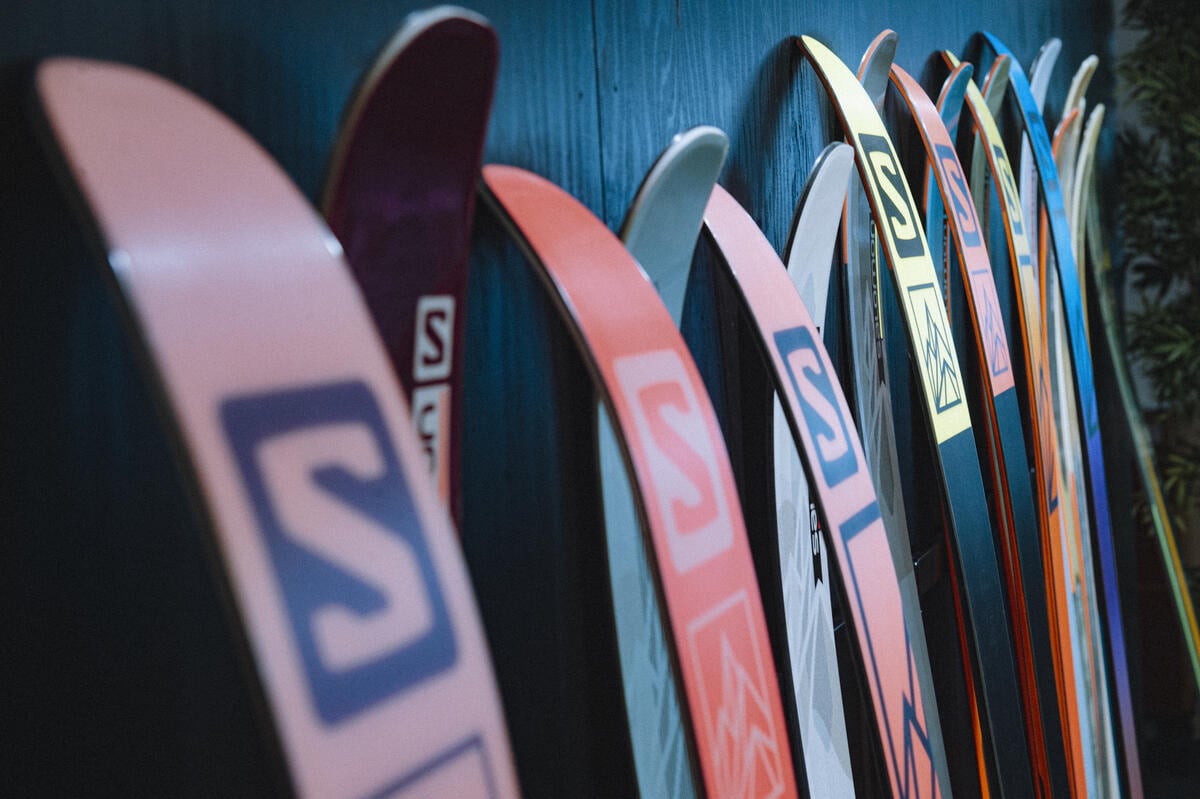
When choosing the right downhill skis it is important to consider the following factors:
1. Decide what type of ski you should use based on the terrain you're skiing on: Options for downhill ski types include on-piste skis, all-mountain skis, freestyle (park) skis, freeride skis, powder skis, race skis, backcountry touring skis, and telemark skis. This decision is based on the what type of skiing you plan to do and what terrain you want to ski on.
2. Choose your ski length: The length of your skis depends mainly on your height and skill level; however, there are a few other factors to take into consideration when deciding on ski length. For more information about ski sizing view our Downhill Ski Length and Sizing section.
3. Ensure the construction of the skis matches your skiing style: Skis come in different widths and sidecuts for different skiing styles so it's important to pick a ski that matches how and where you ski. Also, skis are made of different materials and different rocker profiles for varying skill levels and skiing types. For more information read our Downhill Ski Construction section.
4. Choose between an integrated ski binding or a binding that gets mounted on the ski separately: When purchasing a ski there is the option to get a ski with an integrated binding which is typically more cost effective and offers more adjustment. Many intermediate and advanced skiers prefer to purchase ski bindings separately so they can get a binding that matches their skiing style and skill level.
Downhill Ski Types
On-Piste Skis
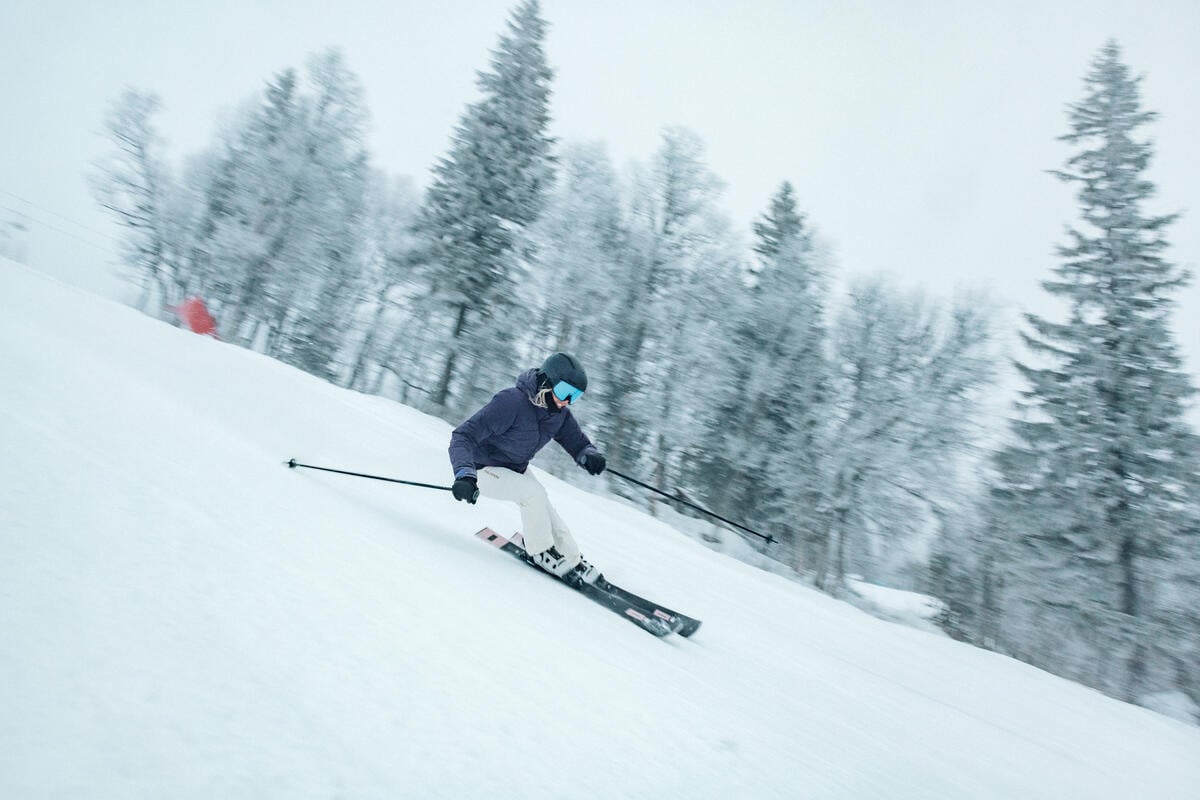
"On-piste skis" refer to a specific type of skis that are designed and optimized for skiing on groomed or prepared slopes, also known as "pistes" or "trails." These skis are tailored to perform well on well-maintained snow conditions typically found in ski resorts. Here are some key characteristics of on-piste skis:
1. Narrower Width: On-piste skis are generally narrower compared to other types of skis. The narrower profile allows for better edge-to-edge contact on groomed snow, providing increased stability and precise control.
2. Camber Profile: Many on-piste skis feature a traditional camber profile. Camber is the slight arch in the middle of the ski when unweighted. This design enhances edge grip and ensures effective power transfer during turns on hard-packed snow.
3. Stiffness and Stability: On-piste skis often have a stiffer construction to provide stability at higher speeds and better response to the skier's movements. This stiffness contributes to the skis' ability to hold an edge on groomed slopes.
4. Carving Ability: These skis are designed for carving turns on groomed terrain. The combination of a narrow waist, camber, and stiffness allows skiers to make precise and controlled turns with minimal effort.
5. High-Speed Performance: On-piste skis excel at higher speeds on well-prepared slopes. The design aims to maximize performance on hard-packed snow conditions commonly found on groomed trails.
6. Edge Control: The construction and design of on-piste skis prioritize effective edge control. This is essential for skiers who want to navigate through groomed slopes with confidence and precision.
7. Responsive Handling: On-piste skis are engineered to respond quickly to skier input. This responsiveness enhances the overall skiing experience, especially when making quick turns or navigating varied terrain within a groomed area.
8. Suited for Intermediate to Advanced Skiers: While beginners can use on-piste skis, these skis are often favored by intermediate to advanced skiers who want to push their limits on well-prepared slopes.
It's important to note that the choice of skis depends on individual preferences, skiing style, and the type of terrain a skier intends to explore. On-piste skis are an excellent choice for those who primarily enjoy skiing on groomed trails and want a ski that maximizes performance in those conditions.
All-Mountain Skis
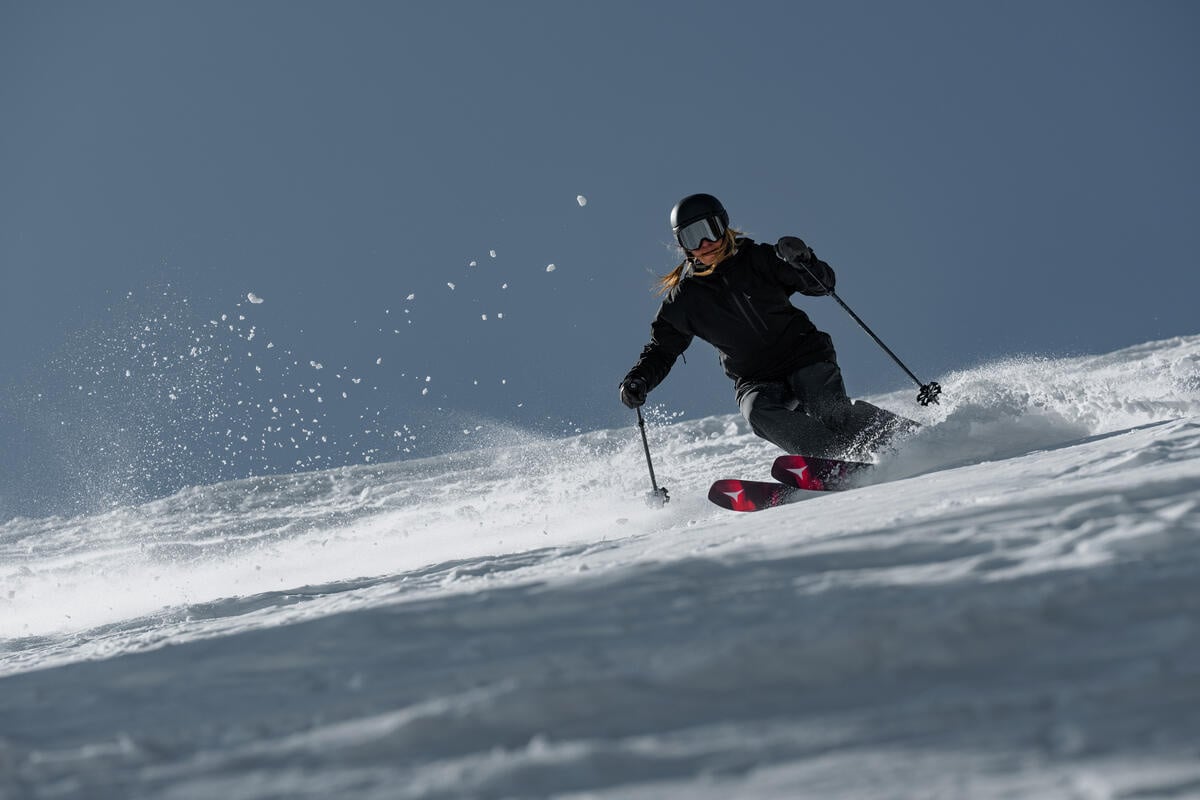
"All-mountain skis" are a versatile type of skis designed to perform well across a variety of snow conditions and terrains. These skis are intended to handle both groomed slopes and off-piste terrain, making them a popular choice for skiers who want a single pair of skis to tackle a range of conditions. Here are some key characteristics of all-mountain skis:
1. Versatility: All-mountain skis are known for their versatility, allowing skiers to navigate a wide range of snow conditions, including groomed trails, powder, crud, and variable terrain.
2. Moderate Width: These skis typically have a moderate width, falling between the narrower on-piste skis and wider powder skis. This width provides a balance between stability on groomed slopes and flotation in softer snow.
3. Rocker-Camber-Rocker Profile: Many all-mountain skis feature a rocker-camber-rocker profile. The rocker (upward curve) at the tip and tail helps with flotation in powder, while the camber (downward curve) underfoot provides stability and edge grip on groomed runs.
4. Adaptability to Various Terrains: All-mountain skis are designed to handle different types of terrain, including groomed trails, moguls, trees, and variable snow conditions. This adaptability makes them suitable for skiers who enjoy exploring the entire mountain.
5. Responsive Handling: While not as specialized as on-piste or powder skis, all-mountain skis are still engineered for responsive handling. This allows skiers to make turns with control and confidence in a variety of situations.
6. Sturdy Construction: All-mountain skis often have a sturdy construction to withstand the demands of varied terrain. This construction may include a mix of materials for durability and performance.
7. Suited for Intermediate to Advanced Skiers: All-mountain skis are well-suited for intermediate to advanced skiers who want a single pair of skis that can handle different types of skiing experiences.
8. Bindings Compatibility: These skis are compatible with a variety of bindings, allowing skiers to customize their setup based on individual preferences and skiing style.
9. All-Terrain Performance: The goal of all-mountain skis is to provide consistent performance across a variety of snow conditions, allowing skiers to enjoy a seamless experience regardless of the terrain.
It's important for skiers to consider their skill level, preferred skiing style, and the types of terrain they frequent when choosing all-mountain skis. These skis offer a well-rounded option for those who want to explore different aspects of the mountain during their skiing adventures.
Freestyle or Park Skis
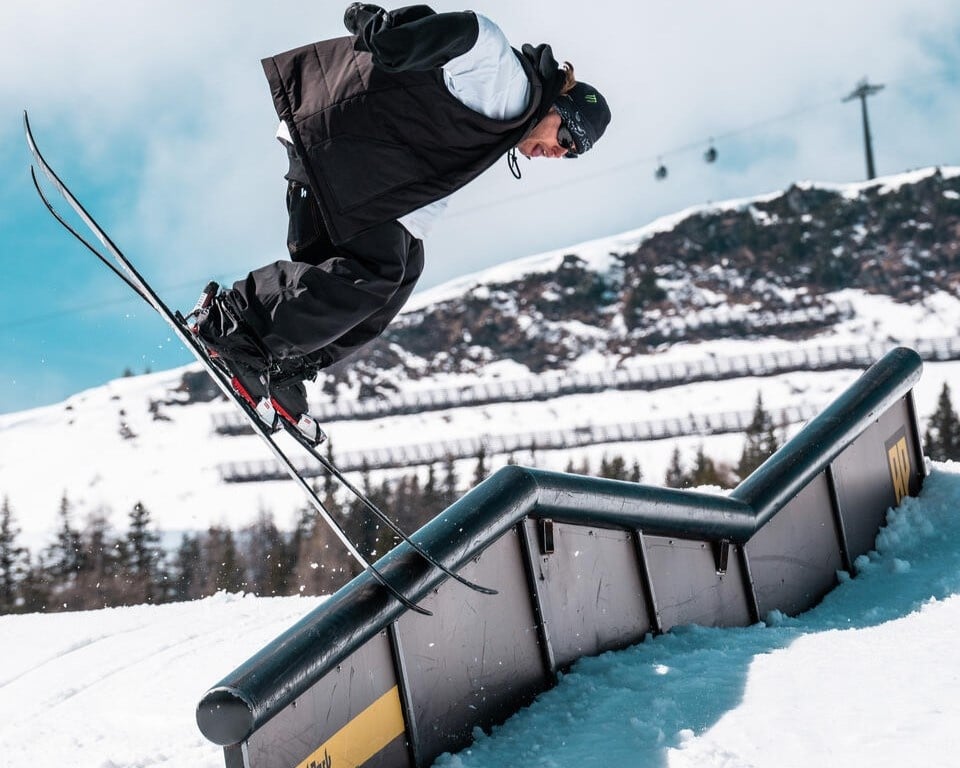
Freestyle or park skis are a specialized type of skis designed for skiers who enjoy performing tricks, jumps, and maneuvers in terrain parks or freestyle areas of ski resorts. These skis are built to provide the flexibility and performance needed for tricks in the park. Here are key characteristics of freestyle or park skis:
1. Twin-Tip Design: Freestyle skis typically have a twin-tip design, meaning both the tip and tail of the ski are turned up. This allows skiers to land and ski backward ("switch") as easily as they ski forward, facilitating tricks and maneuvers.
2. Shorter Length: Freestyle skis are often shorter than other types of skis. The reduced length makes them more maneuverable and agile, allowing skiers to perform spins, flips, and tricks with greater ease.
3. Symmetrical Shape: The skis often have a symmetrical shape, meaning they are the same width at the tip, waist, and tail. This symmetry enhances balance and control when skiing forward or backward.
4. Slightly Wider Waist: While not as wide as powder skis, freestyle skis usually have a slightly wider waist compared to traditional carving skis. This width provides additional stability when landing jumps.
5. Durable Construction: Freestyle skis are constructed to withstand the impacts associated with jumps and tricks. They may have reinforced edges, a robust core, and additional materials to enhance durability.
6. Medium Flex: The flex of freestyle skis is typically medium, offering a balance between stiffness for stability on landings and softness for responsiveness during tricks and maneuvers.
7. Binding Placement: The bindings on freestyle skis are often mounted closer to the center of the ski. This central mounting allows skiers to easily pivot and spin in the air.
8. Park-Specific Graphics: Many freestyle skis feature colorful and vibrant graphics, reflecting the dynamic and energetic nature of park skiing culture.
9. Versatility: While designed for terrain park use, freestyle skis are versatile enough to handle various conditions, including groomed slopes and occasional powder.
10. Suited for Intermediate to Advanced Skiers: Freestyle skis are generally recommended for intermediate to advanced skiers who have developed the skills needed for park skiing and performing tricks.
These skis are ideal for skiers who want to explore terrain parks, halfpipes, and other freestyle features within a ski resort. Whether you're into rail slides, jumps, or spins, freestyle skis provide the tools necessary for expressing creativity and style in the freestyle skiing realm.
Freeride and Powder Skis

"Freeride skis" and "powder skis" are terms often used interchangeably, but they can refer to slightly different types of skis. Both are designed for off-piste skiing, particularly in deep powder snow, but there are nuances in their characteristics.
Freeride Skis:
Freeride skis are versatile skis designed to handle a variety of off-piste conditions, including powder, crud, and variable terrain. Here are key features of freeride skis:
1. Wider Width: Freeride skis typically have a wider waist compared to traditional carving skis. The increased width provides better flotation in powder and stability on ungroomed terrain.
2. Rockered Profile: Freeride skis often feature a rockered profile, where the tip and sometimes the tail are lifted off the snow. This design helps the skis float on top of powder, making them more maneuverable in deep snow.
3. Tapered Shape: Many freeride skis have a tapered shape, with a wider tip compared to the tail. This enhances turn initiation and maneuverability in varied conditions.
4. Versatile Performance: Freeride skis are designed to perform well in a variety of conditions, not just powder. They can handle mixed terrain, moguls, and other challenges found off-piste.
5. Bindings Compatibility: Freeride skis may be compatible with bindings that offer a walking or touring mode, allowing skiers to explore backcountry areas.
Powder Skis:
Powder skis are a subset of freeride skis specifically engineered for optimal performance in deep powder snow. Here are key features of powder skis:
1. Very Wide Waist: Powder skis have an exceptionally wide waist, often exceeding 100mm or more. This width provides maximum surface area for enhanced flotation in deep powder.
2. Aggressive Rocker: Powder skis typically feature an aggressive rocker profile, lifting the tip and sometimes the tail significantly off the snow. This design allows the skis to effortlessly glide over deep powder without getting buried.
3. Directional or Symmetrical Shape: Powder skis may have a directional shape (wider tip than tail) or a symmetrical twin-tip design, depending on whether they are primarily used for forward or switch skiing.
4. Minimal Sidecut: Powder skis often have a minimal sidecut, allowing for smooth and predictable turns in deep snow without catching edges.
5. Specialized for Deep Powder: While freeride skis handle various conditions, powder skis are specifically engineered for the unique challenges and joys of skiing in deep, untracked powder.
Both freeride and powder skis cater to skiers who enjoy venturing off-piste, exploring ungroomed terrain, and experiencing the thrill of deep powder. The choice between freeride and powder skis depends on individual preferences, the specific type of skiing terrain, and the desired skiing experience.
Race Skis

"Race skis" are a specialized type of skis designed specifically for competitive alpine ski racing. These skis are engineered to provide the utmost precision, control, and speed required by elite skiers participating in slalom, giant slalom, super-G, and downhill racing events. Here are some key characteristics of race skis:
1. Narrow Width: Race skis are typically narrower than other types of skis, especially in comparison to all-mountain or powder skis. The reduced width allows for quick edge-to-edge transitions and precise carving.
2. Long Length: Race skis are often longer than other types of skis, providing stability and increased speed. The length contributes to better stability at high speeds and enhances the skier's ability to maintain control during aggressive turns.
3. Stiff Flex: Race skis have a stiff flex, meaning they require more force to bend. This stiffness provides enhanced edge grip and responsiveness, allowing skiers to make sharp turns and maintain control while navigating through race courses.
4. Slalom vs. Giant Slalom Design: There are different designs for slalom and giant slalom race skis. Slalom skis are shorter with a tighter turning radius, allowing for quick and agile turns around gates. Giant slalom skis are longer with a larger turning radius, suitable for the longer, more sweeping turns in giant slalom races.
5. Camber Profile: Race skis often feature a full camber profile, meaning they have a slight upward curve in the middle when unweighted. This camber profile provides additional edge contact, ensuring optimal grip on hard-packed snow.
6. Titanal Layers: Many race skis incorporate layers of Titanal, a high-strength aluminum alloy, to enhance stability, dampen vibrations, and increase torsional rigidity. This contributes to the ski's ability to hold an edge at high speeds.
7. Bindings Integration: Race skis are designed to work seamlessly with race-specific bindings. These bindings are often mounted to optimize power transmission and responsiveness.
8. Lightweight Construction: While race skis are sturdy, they are also designed to be lightweight to allow for quick, agile movements required in racing.
9. Professional-Level Equipment: Race skis are typically used by professional or highly competitive skiers who participate in alpine ski racing events at various levels, including World Cup competitions.
It's important to note that race skis are not recommended for recreational skiers or those who are not engaged in competitive racing. Their specialized design makes them suitable for the specific demands of alpine racing but may be challenging for general skiing purposes. Skiers interested in race skis should consider their skill level, racing aspirations, and the specific discipline they plan to compete in before making a purchase.
Backcountry Touring Skis

Backcountry touring skis are a specialized type of skis designed for skiers who venture into the backcountry, away from groomed slopes and ski resorts. These skis are engineered to provide the best combination of weight, durability, and performance for uphill climbing as well as downhill skiing in varied off-piste conditions. Here are key characteristics of backcountry touring skis:
1. Lightweight Construction: Backcountry touring skis prioritize weight savings to make uphill climbing more efficient. They often use lightweight materials, including advanced composites and carbon fiber.
2. Narrower Width: While not as narrow as traditional racing skis, backcountry touring skis are generally narrower than freeride or powder skis. The reduced width helps with maneuverability and climbing efficiency.
3. Rockered Profile: Many backcountry skis feature a rockered profile, with an upward curve at the tip. This design aids in powder skiing and helps prevent the ski tips from diving into soft snow during descents.
4. Touring-Specific Bindings Compatibility: Backcountry skis are designed to work with touring-specific bindings, which often have a "free heel" design for uphill climbing. These bindings allow the skier to lift their heels for walking or skinning up slopes.
5. Skin Attachments: Backcountry skis often have integrated or compatible attachments for climbing skins. Climbing skins are removable, adhesive-backed fabric strips that attach to the base of the skis, providing traction for ascending slopes.
6. Bindings with Climbing Aids: Touring bindings may include climbing aids or "risers" that can be adjusted to different heights. These aids help reduce calf fatigue during uphill climbs by providing a more comfortable angle for the skier's leg.
7. Durable and Resilient Construction: Backcountry skis are built to withstand the challenges of off-piste terrain, including encounters with rocks, stumps, and other obstacles. They often have reinforced edges and durable construction.
8. Versatile Performance: Backcountry touring skis are designed for both uphill and downhill performance. Skiers can climb uphill using climbing skins, and then transition to downhill skiing for the descent.
9. Slightly Tapered Shape: Some backcountry skis may have a slightly tapered shape, providing a balance between turn initiation and stability in variable snow conditions.
10. Variable Flex: The flex of backcountry touring skis can vary, but they are generally designed to be responsive enough for downhill skiing while maintaining efficiency for uphill climbing.
Backcountry touring skis are ideal for skiers who want to explore remote, untracked terrain, and enjoy the freedom of climbing and skiing in the backcountry. Paired with specialized backcountry touring bindings, boots, and climbing skins, these skis provide the tools for a complete backcountry skiing experience.
Telemark Skis
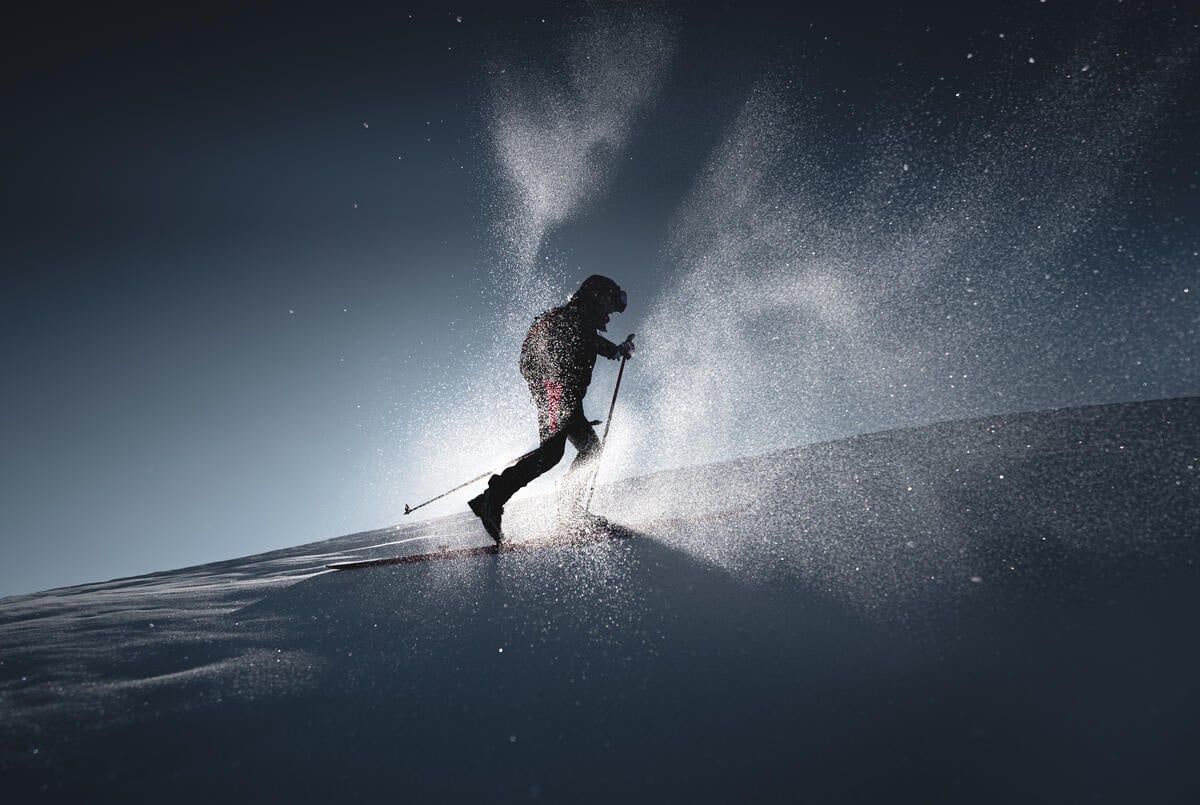
Telemark skis, also known as "telemark" or "free-heel" skis, are a specialized type of skis designed for a particular skiing technique called telemark skiing. Telemark skiing involves a distinct combination of downhill and cross-country skiing, characterized by a free-heel binding system. Here are key characteristics of telemark skis:
1. Free-Heel Binding: The defining feature of telemark skis is the free-heel binding system. Unlike alpine skiing, where the heel is fixed to the ski, telemark bindings allow the heel to lift off the ski during the uphill stride and provide flexibility for turns during the descent.
2. Classic Telemark Shape: Telemark skis typically have a classic telemark shape, which includes a moderate sidecut, a cambered profile, and a slightly tapered tip. This shape is optimized for the unique turns and techniques associated with telemark skiing.
3. Twin-Tip Design: Many modern telemark skis feature a twin-tip design, with both the tip and tail turned up. This design facilitates backward skiing ("switch") and allows for more versatility in maneuvers and tricks.
4. Versatile Terrain Performance: Telemark skis are designed for versatility and can handle a variety of terrain, including groomed slopes, powder, and backcountry terrain. The free-heel binding system provides the skier with the ability to climb uphill using a walking or climbing motion.
5. Backcountry-Friendly: Telemark skiing is well-suited for backcountry skiing, and telemark skis are often used in combination with climbing skins for uphill ascents in untracked snow.
6. Variable Flex: Telemark skis can have a variable flex depending on the intended use. Some are designed for more aggressive downhill skiing, while others may have a softer flex for backcountry touring.
7. Durable Construction: Telemark skis are constructed to withstand the rigors of both on-piste and off-piste skiing. They often have reinforced edges and durable materials.
8. Telemark Boots Compatibility: Telemark boots are a crucial component of the setup. These boots have a flexible sole to allow for the distinctive telemark turn and interface with the free-heel bindings on the skis.
9. Binding Options: Telemark bindings come in various designs, including traditional cable bindings, NTN (New Telemark Norm) bindings, and others. The choice of binding affects the skier's control and feel while making telemark turns.
10. Niche Skiing Technique: Telemark skiing is a unique and distinct technique that combines elements of both alpine and Nordic skiing. It has a dedicated community of enthusiasts who appreciate the fluid and expressive nature of the telemark turn.
Telemark skiing is known for its graceful and flowing turns, providing skiers with a different experience compared to alpine skiing. It requires a combination of balance, strength, and technique, making it a rewarding and challenging form of skiing.
Downhill Ski Length and Sizing
Choosing the right size for your skis is a crucial aspect of ensuring an optimal and enjoyable skiing experience. Ski sizing is influenced by various factors, and finding the perfect fit involves considering your height, weight, skiing ability, and the type of terrain you plan to explore. Below are recommendations for picking the correct ski length that best fits your needs.
General Sizing Chart
|
Rider Height (FT, IN)
|
Rider Weight |
Ski Length (Beginner to Expert)
|
| 4' |
50 lbs - 70 lbs |
100 cm - 125 cm |
| 4'2" |
60 lbs - 80 lbs |
110 cm - 130 cm |
| 4'4" |
70 lbs - 90 lbs |
115 cm - 135 cm |
| 4'6" |
80 lbs - 100 lbs |
120 cm - 140 cm |
| 4'8" |
90 lbs - 110 lbs |
125 cm - 145 cm |
| 4'10" |
100 lbs - 120 lbs |
130 cm - 150 cm |
| 5' |
110 lbs - 130 lbs |
135 cm - 155 cm |
| 5'2" |
120 lbs - 140 lbs |
140 cm - 160 cm |
| 5'4" |
130 lbs - 145 lbs |
145 cm - 165 cm |
| 5'6" |
140 lbs - 160 lbs |
150 cm - 170 cm |
| 5'8" |
160 lbs - 175 lbs |
155 cm - 175 cm |
| 5'10" |
170 lbs - 190 lbs |
160 cm - 180 cm |
| 6' |
180 lbs - 200 lbs |
165 cm - 185 cm |
| 6'2" |
200 lbs - 220 lbs |
170 cm - 190 cm |
| 6'4" |
220+ lbs |
175 cm - 200 cm |
*This is a recommendation. Ski lengths can vary by skill level, riding style, ski type, and rider preference. Beginners; all- mountain riders; and riders who prefer to make short, quick turns instead of caring about speed generally want skis on the shorter end of the range. Advanced riders, powder/off-trail riders, and riders who ski fast and aggressively generally want skis on the longer end of the range. Most ski manufacturers provide sizing charts that take into account your height, weight, and skiing ability. Check the sizing recommendations for the specific ski model you're interested in and consider the following ski sizing factors below.
1. Consider Your Height: When selecting the size of your skis, it's essential to strike a balance between stability, maneuverability, and control. Generally, taller skiers may prefer longer skis for added stability and better performance at high speeds, while shorter skiers might find shorter skis more maneuverable and easier to control, especially in tighter turns.
2. Factor in Your Weight: Your weight plays a significant role in the flex and performance of the skis. Heavier skiers often benefit from longer skis, as the additional length provides stability and helps distribute their weight more effectively. Lighter skiers might find shorter skis more responsive and easier to handle.
3. Assess Your Skiing Ability: Consider your skiing ability and style when determining ski size. Beginners may find shorter skis more manageable, allowing for easier turn initiation and control. Advanced and expert skiers might prefer longer skis for stability at higher speeds and when tackling challenging terrain.
4. Consider Skiing Style and Terrain: The type of terrain you plan to ski on also influences ski size. If you primarily enjoy groomed slopes and carving, a different ski size may be suitable compared to someone exploring powder, moguls, or backcountry terrain. Skis designed for specific purposes, such as powder skis or carving skis, may have different size recommendations.
-For example:
-Carving Skis: Shorter skis are often preferred for quick turns on groomed slopes.
-All-Mountain Skis: A balanced length provides versatility across various terrains.
-Powder Skis: Longer skis with a wider profile offer better flotation in deep powder.
-Recommendations based on ski type:
-On-piste Skis: Between 15cm and 5cm shorter than you
-All-mountain Skis: From 10cm shorter than you up to your actual height
-Freeride or Powder Skis: Between 5cm and 10cm taller than you
-Backcountry Skis: Your height +/- 5cm
-Touring Skis: Between 5cm and 10cm shorter than you
-Freestyle Skis: From 10cm shorter than you up to your actual height
5. Understand Ski Design Features: Ski design features, such as sidecut (the difference in width between the tip, waist, and tail) and rocker profile, can affect how skis perform. A ski with a deeper sidecut may be more maneuverable, while a ski with a shallower sidecut may provide stability at speed.
6. Seek Expert Advice: Consult with our experienced ski shop staff who can provide personalized recommendations based on your skiing goals and preferences.
7. Check Manufacturer Recommendations: Some ski manufacturers offer specific recommendations for their ski models based on factors like skier ability and intended use. Look for the manufacturer's guidelines for each ski model.
It's important to note that personal preferences play a role in ski length selection, and there is no one-size-fits-all answer. Finding the right ski length involves a combination of guidelines, experimentation, and considering your own comfort and enjoyment on the slopes.
Downhill Ski Gender and Age Considerations
Men's vs Women's Skis

The difference between men's and women's downhill skis lies in various design aspects tailored to accommodate physiological and biomechanical differences between genders. While individual preferences play a role, here are common distinctions:
1. Length and Flex: Women's skis are often available in shorter lengths and have a softer flex compared to men's skis. This acknowledges that, on average, women tend to be lighter and have a lower center of gravity.
2. Waist Width: Women's skis may have a slightly narrower waist width than men's skis. This is based on the assumption that women, on average, have a lower body weight and may benefit from skis that are easier to turn.
3. Bindings: Women's ski bindings are often mounted slightly forward compared to men's bindings. This accounts for differences in stance and physiology, aiming to optimize performance and reduce the risk of injury.
4. Flex Pattern: Women's skis typically have a flex pattern that is tuned to accommodate lighter and less muscular skiers. This allows for better control and responsiveness.
5. Graphics and Aesthetics: While not impacting performance, women's skis often feature different graphics and color schemes. This is done to cater to varying aesthetic preferences.
It's important to note that these differences are generalizations, and there is significant variation within each gender. Individual skier preferences, skill levels, and body types also play a crucial role in determining the most suitable ski equipment. Additionally, some unisex or gender-neutral skis are designed to offer versatility for a broad range of skiers.
Youth Skis

Youth downhill skis are specifically designed to accommodate the smaller size, lighter weight, and different skiing abilities of younger skiers. Here are some key differences between youth downhill skis and adult skis:
1. Size and Length: Youth skis are shorter in length compared to adult skis. This is to match the height and size of younger skiers, providing better control and maneuverability.
2. Flex Rating: Youth skis have a softer flex to match the lower body weight of young skiers. A softer flex allows for easier turn initiation and greater control.
3. Bindings: Youth ski bindings are designed to accommodate smaller ski boots. They may also have adjustable features to allow for growing feet.
4. Graphics and Design: Youth skis often feature graphics and designs that appeal to younger skiers. Bright colors and fun patterns are common to make the equipment visually appealing.
5. Construction Materials: The construction materials in youth skis are chosen to provide durability and performance suitable for beginners and developing skiers. The emphasis is on creating a forgiving and easy-to-use ski.
6. Weight: Youth skis are lighter than adult skis, making them more manageable for younger skiers. Lighter skis are easier to carry and control.
7. Ski Width: Youth skis may have a narrower waist width to match the smaller stature of young skiers. This facilitates easier turn initiation on groomed slopes.
8. Cost: Youth skis are often more affordable than adult skis, recognizing that parents may need to replace equipment as their children grow.
9. Usage: Youth skis are designed for beginner and intermediate skiers who are still developing their skills. They are typically suited for groomed slopes and introductory terrain.
It's crucial for parents or guardians to regularly assess the sizing of youth skis, as children grow quickly. Investing in properly sized and designed youth skis ensures a safer and more enjoyable skiing experience for young enthusiasts.
Related Links
Downhill Ski Construction Guide











